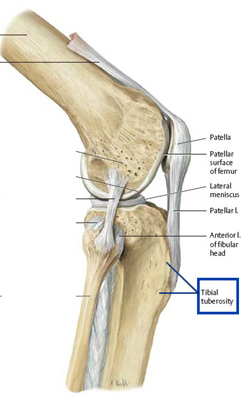What is the tibial tubercle?
 The tibial tubercle is the insertion point of the patella tendon. This is found below the kneecap (patella) on the
front of the tibia. It is also known as the tibial tuberosity.
The tibial tubercle is the insertion point of the patella tendon. This is found below the kneecap (patella) on the
front of the tibia. It is also known as the tibial tuberosity.
What is a tibial tubercle osteotomy?
A Tibial Tubercle Osteotomy (TTO) is surgery to move the insertion point of the patella tendon and fix it in a new position with screws. The tubercle is commonly moved distally or medially depending on the indication for surgery. The surgery may be combined with other procedures such as knee arthroscopy or MPFL reconstruction.
What knee problems can an osteotomy help with?
A TTO is done to improve patellofemoral joint instability and/or decrease pressure on the patellofemoral joint (Anterior knee pain). The surgery will improve the way the patella sits within the trochlea, which is the groove at the front of the femur.
In the setting of early Patellofemoral joint arthritis or proximal patella tendon impingement, then a TTO to move the patella distally can help to offload the pressure on the painful areas.
What happens during TTO surgery?
The surgery may be combined with other procedures such as knee arthroscopy or MPFL reconstruction.
Under a general or spinal anaesthetic, a knee arthroscopy is performed to assess and manage the joint surfaces of the knee. A 10cm incision is then made next to the tibial tubercle. A hamstring graft is taken at this point if an MPFL reconstruction is being performed.
Using a surgical saw, a 7cm length of bone (the osteotomy) is carefully separated from the front of the tibia with the patella tendon attached. A small wedge of bone is then removed, and the bone fragment is moved and re-attached firmly in the new position with a combination of screws and/or a plate.
The knee is moved through a range of motion to ensure the osteotomy is stable and the patella is reduced. The incision is closed with dissolvable sutures and local anaesthetic is used to help with pain relief post-operatively.
You will go home the day after surgery, ensuring any pain is well managed and you are safe for discharge. Before you leave hospital, your surgeon from Melbourne Hip and Knee will talk to you about the findings of the operation and the management performed. A physiotherapist will review you and discuss the exercises that are permitted and, if required, how to use a brace.
What happens after TTO surgery?
You will be given instructions about how to care for your knee and the dressings in the first two weeks. You will be able to weight bear through your knee, using a brace and crutches for the first 6 weeks. Guided by your physiotherapist, you will be able to move your knee, increasing the range of motion over the first 6 weeks. It is common to have some mild pain and swelling for a few weeks after your surgery, and your surgeon will ensure that you have adequate pain relief to go home with.
Post operative recovery
Your surgeon will see you at two weeks in our rooms at MHK to ensure you have recovered well, and to explain the findings and management of the surgery again. A second appointment is organised at 6 weeks with an x-ray to check the osteotomy is healing and to progress your rehabilitation.
You should be able to return to a desk job after 2 weeks. More active work and certain sporting activities will need to wait until the osteotomy is united and your range of motion has returned. Deep squats should be avoided for 3 months. You will be given some physiotherapy exercises and it is important to perform these until your muscle function has returned.
The metalware within the osteotomy doesn’t need to be removed. Occasionally, the screws can cause some minor irritation. This may require removal of the metalware once the osteotomy is healed. Your surgeon at MHK will discuss this with you if required.

